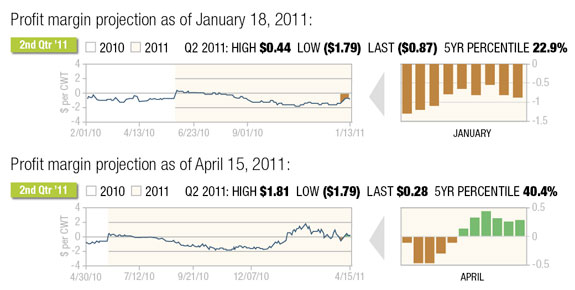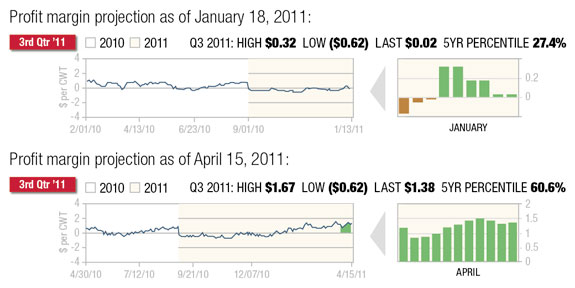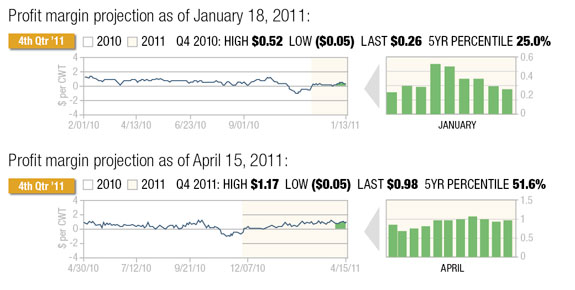Since we last updated the profit margin outlook for dairy producers in 2011 back in January, things have continued to improve with forward margins strengthening through the remainder of the year into early 2012. What was projected as a breakeven to slightly positive forward margin at best during the second half of the year is now decisively in the black as increasing milk values have more than offset the impact of higher feed costs that dairies will have to absorb on their herds.
While managing profitability will continue to pose a challenge for dairy producers struggling to rebuild lost equity, it is encouraging that what appeared to be a turning of the tides back in January still suggests a brighter outlook for 2011.

Figures in this article reflect both the current outlook for dairy margins throughout 2011 into the first quarter of 2012 as well as comparison graphs to these same forward profit margin projections back in January.
You will notice that what was projected as a loss for the current Q2 period is now reflecting a profit, while margins in both Q3 and Q4 are also higher than where they were a few months ago.
Q1 2012 margins that we just began tracking are basically reflecting a breakeven scenario for dairy producers early next year.

Assessing the margin outlook, feed costs remain a major concern of dairies, as the price of corn has soared since last fall’s harvest. Simply put, supply has not kept pace with demand, which has allowed buffer stocks to decline to precariously low levels not seen in years.
The latest forecast from the USDA projected ending stocks in the current marketing year to total only 675 million bushels at the end of August.
While in years past this may have been considered an adequate supply, it now only represents 5 percent of total projected demand, which would be the tightest balance since the 1995-96 crop year.

To make matters worse, it also appears that this forecast may be optimistic in light of more recent data. The USDA released its quarterly stocks report on March 31, which pegged corn stocks in all positions on March 1 at 6.52 billion bushels.
This figure was nearly 200 million bushels below the average trade estimate, as well as outside the range of pre-report forecasts.
Corn disappearance during the Dec/Jan/Feb period was obviously much stronger than previously expected, suggesting domestic demand is running at a faster pace than the market can bear this season.

Given that export demand is relatively transparent as it is measured and reported weekly by the USDA, quarterly stocks help gauge domestic demand, which consists primarily of the ethanol and livestock feed sectors.
It is clear that margins for both sectors have supported demand for corn at current price levels, although it now appears that corn may need to discover a higher price level that will help ration demand through the remainder of the crop year and maintain a minimum pipeline ending stocks forecast.
Given that corn stocks are projected to be so tight in the current season, another concern of the market is the outlook for this year’s crop. The USDA also issued its Prospective Plantings report on March 31, which projected corn acreage in 2011 at 92.2 million, up 4 million acres or 4.5 percent from last year.
Assuming a normal ratio of harvested-to-planted-acres as well as trendline yields, this would produce a crop of about 13.755 billion bushels. However, given demand expectations similar to this year, ending stocks would only increase slightly to around 930 million bushels.
This is still historically tight relative to projected demand, so the market will be highly sensitive to weather developments over the spring and summer, as there is no margin for error should any problems develop during the planting and growing seasons.
Meanwhile, the outlook for soybean meal prices is likewise concerning, although perhaps not as dire as corn. Projected supplies of soybean stocks to be left over at the end of the current crop year are also historically tight, at 4.2 percent of total usage.
Like corn, this is a multi-year low and current price levels reflect this tight supply/demand balance. Also similar to corn, the quarterly stocks figure released on March 31 at 1.25 billion bushels was both below average estimates as well as the range of pre-report expectations, suggesting that ending stocks may decline further in upcoming reports, as disappearance is running faster than previously forecast.
On a positive note, it appears that South America is harvesting a large soybean crop, which will help to alleviate some of the global tightness over the summer. Because both Brazil and Argentina are major suppliers of soybeans and soybean products to the world market, this provides somewhat of a cushion to the tight domestic supply/demand balance in the U.S.
Unfortunately, soybeans are forecast to lose ground in the acreage battle this season, given higher projected profitability for competing crops such as corn, cotton and wheat. The USDA forecast 2011 soybean plantings on March 31 at 76.6 million acres, down 800,000 or 1 percent from last year.
While this does not sound like a big number, given the tight ending stocks projection for the current season, trendline yields will only produce a crop of around 3.29 billion bushels, which will not allow stocks to grow at all year over year. Given this scenario, the soybean meal market will likewise be highly sensitive to weather developments over the spring planting and summer growing seasons.
Also, like soybeans, hay acreage is projected down 890,000 acres from last season as it loses ground to more profitable crops, which is a negative development for forward dairy feed prices as well.
Meanwhile, milk prices have maintained at higher levels after soaring during the first quarter of the year. While nearby futures values represented by the Class III contract at the CME appear to have topped out in mid-February, an interesting development since our last report is that deferred contracts have been able to post new highs as recently as of this writing in mid-April.
Previously, deferred contracts were trading at a discount to spot values such that the forward price curve was inverted. Now, the forward curve is flatter, which suggests there may be a shift in sentiment that current high price levels can be maintained throughout the year.
To be sure, the USDA has consistently raised its average price projections for 2011 in the monthly WASDE, giving credence to ideas that prices may indeed be able to sustain at higher levels given the current strength of demand.
As of our last writing, butter was trading above $2.00 per lb, and the strength of the butter and powder markets were the primary drivers of milk value, with Class IV prices trading at historically high premiums over Class III. This is still the case, although cash cheese prices showed a similarly strong advance before dropping sharply during the second half of March.
Cheese demand has been very strong as the latest Cold Storage report revealed a contra-seasonal 2.0 percent decline in cheese stocks during February while November-January cheese disappearance was up 5.8 percent from a year ago and the highest since the summer of 2005.
It may be that high prices have discouraged manufacturers from putting cheese into storage though, and heavy offers on block and barrel cheese in the spot cash call at the CME were responsible for the mid-month crash in March.
Another concerning item is that world prices have been softening lately, which could reverberate back to the U.S. market as well. According to the latest Dairy Market News survey, buyers are becoming more cautious with European whey prices down about 10 cents from a month ago at $0.57-$0.61 per pound, while Oceania SMP is $1.54-$1.72 per pound, down about $0.18 per pound.
This drop follows a similar $0.05 per pound decline two weeks ago when SMP prices were trading at a three-year high. Although butter and powder stocks remain low, it does appear that high prices have begun to impact demand at the same time we are moving into the spring flush season.
The results of the latest Fonterra auction also show a similar trend, with the weighted average price for WMP at $3,878 per ton ($1.76 per pound), down 5.6 percent from March 15 and down 16.0 percent from a month ago.
This brings us back to the topic of forward dairy margins. While currently profitable, it is important to remember that these are merely projections based on looking at feed costs against milk revenue in a model incorporating other fixed-cost assumptions.
Because these prices change over time for reasons that we cannot always anticipate in advance, it is important to capture opportunities when they present themselves. While we do not know what the future holds for feed costs or milk prices, it is possible to ascertain risk to our profitability from a margin perspective.
Based on known factors, there is obviously the potential for increasing corn and soybean meal prices through the spring and summer. Similarly, given signs of slowing demand, there is also the possibility that milk prices could decline from current levels.
Either of these developments, and particularly both at the same time, would be detrimental to a dairy’s forward profitability.
In addition, because these forward margin projections are subject to change based on dynamically changing prices, it is important to incorporate flexibility into strategies that protect this profit margin.
As an example, protecting a minimum price level for milk revenue while allowing for prices to improve in a rising market would have been necessary to capture the gains realized during the first quarter of the year when Class III futures increased $3.00 per hundredweight (cwt).
Similarly, flexibility in protecting feed costs would have likewise preserved the opportunity to participate in the sharp selloff that occurred during the catastrophic events in Japan recently, when corn dropped more than $1.00 per bushel while soybean meal prices declined around $30 per ton.
Because it is not necessarily obvious how prices will change, or what factors will drive these changes in price, it is important to consider risk within the larger context of overall profitability.
Focusing on profit margin management takes the emotion out of looking at daily price swings in the component markets that make up this margin, and brings more clarity to the risk management challenge. In taking a margin perspective, a dairyman can have more control in protecting their profitability in these volatile times of dynamically changing prices.
Fortunately, current price levels do suggest positive returns to dairymen for the remainder of 2011 which can be captured through proactive contracting right now. PD
References omitted due to space but are available upon request to editor@progressivedairy.com .

-
Chip Whalen
- Senior Risk Manager and Director of Education
- Commodities & Ingredient Hedging, LLC
- Email Chip Whalen







